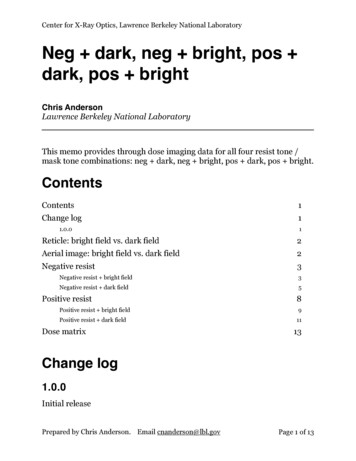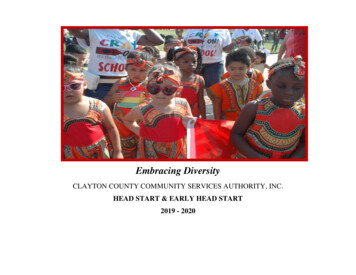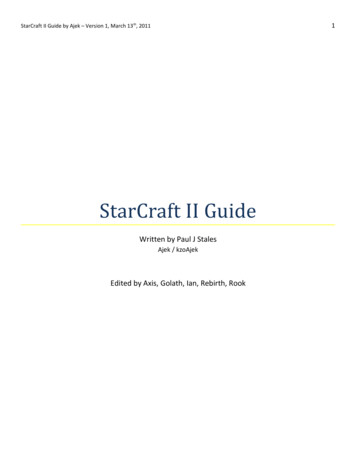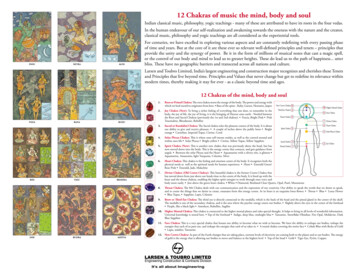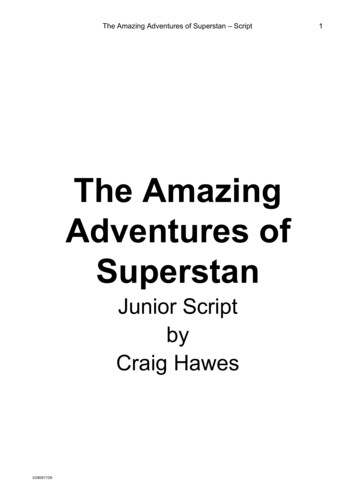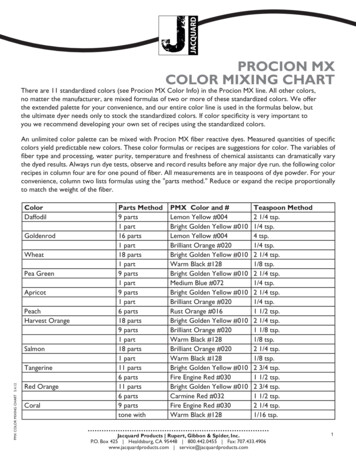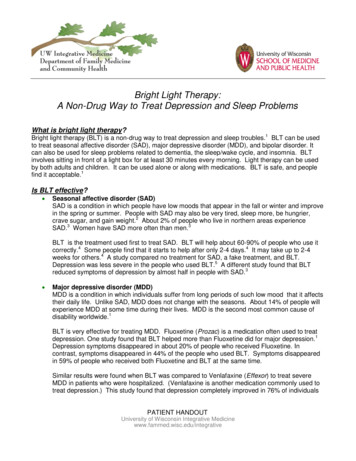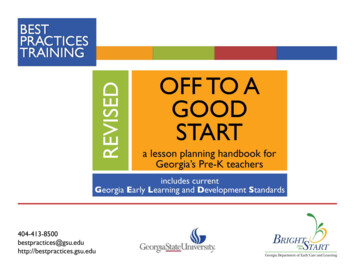
Transcription
acknowledgementsOff to a Good Start: a lesson planning handbook for Georgia’s Pre-K teachersSuzanne TurnerAssociate Project DirectorBest Practices TrainingGeorgia State UniversitySherry HowardProject DirectorBest Practices TrainingGeorgia State UniversityThank you to the following contributorsPre-K TeachersConnie EllingtonBecky GianinoLourdes LucarelliEllen McNeilBecky ThomasBright From The Start: Georgia Department of Early Care and LearningChristi BedwellPeggy KosaterPam BojoJennifer McCrearyJudy CarterLaurianne McDonaldDeanna Echols-HibbardKay PollardBranda FarrowDarlene SimsBest Practices: Georgia State UniversityLynda PearceMaria SamotCheryl Turnerand to the rest of the Best Practices staff for their invaluable supportKelly StaderSusan SimpsonKamren ToddMonica WarrenVicki Watts
Off to a Good Start:a lesson planning handbook for Georgia’s Pre-K teachersThis handbook is designed for teachers new to Georgia’s Pre-K; however, it is a resource that all teachers are encouraged to use. Insideare 12 weeks of comprehensive lesson plans, including developmentally appropriate activities and strategies for future planning. Specificsections are provided that give guidance regarding assessment and setting up small groups, as well as ideas for books, songs andtransitions.SUGGESTIONS FOR USEYou may use this handbook in several ways:Print the lesson templates and use them exactly as they are written.Rearrange the sections so that they meet an existing schedule.Cut and paste portions of the lesson plan(s) to use in your classroom.Veteran teachers may search the handbook for ideas for lessons, books or CDs to use in their classrooms.LESSONSThe lessons are designed to introduce children and teachers to the materials and routines used throughout the Pre-K day. In addition,books and activities help to develop topics of study.Weeks 1-3My School/My FriendsWeeks 4-6ShoesWeeks 7-9Rhyme TimeWeeks 10-11Author StudyWeek 12Your choice of topicEXPANDED LESSON PLANSEach section begins with the lesson plan template, followed by the small group and assessment templates. After the templates areexpanded lesson plans which include a detailed, step-by-step explanation of each of the activities. It is important that you read theexplanations carefully. Simply browsing the templates will not give you the in-depth information you need. Feel free to substitute booksor CDs if the specific titles listed in the handbook are not available. Consider the intent of the lesson and choose an alternate accordingly.Be sure you are familiar with any allergy concerns before implementing cooking/snack activities, and substitute ingredients as needed.1
BOOK LIST (alphabetical by title)A Monster Sandwich by Joy CowleyA Splendid Friend Indeed by Suzanne BloomAlligator Shoes by Arthur DorrosBirdie’s Big-Girl Shoes by Sujean RimBoomer Goes to School by Constance W.McGeorgeBrown Bear, Brown Bear, What Do You See? byBill MartinCaps for Sale by Esphyr SlobodkinaChicka Chicka Boom Boom by Bill MartinChrysanthemum by Kevin HenkesCinderella by Marcia BrownCookie’s Week by Cindy WardCool Dog, School Dog by Deborah HeiligmanCorduroy by Don FreemanCows Can’t Fly by David MilgrimDinosaur Starts School by Pamela DuncanEdwardsDon’t Let the Pigeon Drive the Bus! by MoWillemsDuck in a Truck by Jez AlboroughEgg Drop by Mini GreyFirst Day Jitters by Julie DanneburgFranklin Goes to School by Paulette BourgeoisFriends by Helme HeineFrog and Toad Are Friends by Arnold LobelHooway for Wodney Wat by Helen LesterHow to Lose All Your Friends by Nancy CarlsonI Like Me! by Nancy CarlsonI Went Walking by Sue WilliamsIf You Give a Dog a Donut by Laura NumeroffIf You Give a Mouse a Cookie by Laura NumeroffIf You’re Happy and You Know It Jungle Edition byJames WarholaIra Sleeps Over by Bernard WaberIt’s Mine! by Leo LionniJump, Frog, Jump! by Robert KalanKing Bidgood’s in the Bathtub by Audrey WoodLittle Blue and Little Yellow by Leo LionniMay I Bring A Friend? by Beatrice de RegniersMean Soup by Betsy EverittMortimer by Robert MunschMother Goose Tales to Read Together by MaryAnn HobermanMouse’s First Day of School by Lauren ThompsonMrs. Grindy’s Shoes by Joy CowleyMy Friends Mis Amigos by Taro GomiMy Teacher Sleeps in School by Leatie WeissNew Shoes for Silvia by Johanna HurwitzNo David! by David ShannonOff to School Baby Duck by Amy HestPete the Cat I Love My White Shoes by Eric LitwinPete the Cat Rocking in My School Shoes by LitwinPeter’s Chair by Ezra Jack KeatsRex by Ursula DubosarskySheep in a Jeep by Nancy ShawShoe-la-la by Karen BeaumontShoes by Elizabeth WinthropShoes Shoes Shoes by Ann MorrisSilly Sally by Audrey WoodSplat the Cat by Rob ScottonStand Tall Molly Lou Melon by Patty LovellThe Adventures of Taxi Dog by Debra and SalBarraccaThe Cow Loves Cookies by Karma WilsonThe Elves and the Shoemaker by Jacob GrimmThe Foot Book by Dr. SeussThe Gingerbread Man by Catherine McCaffertyThe Grouchy Ladybug by Eric CarleThe Kissing Hand by Audrey PennThe Little Engine That Could by Watty PiperThe Napping House by Audrey WoodThe Pigeon Wants a Hotdog by Mo WillemsThe Rain Came Down by David ShannonThe Rainbow Fish by Marcus PfisterThe Very Busy Spider by Eric CarleThere Was an Old Lady Who Swallowed a Fly bySimms TabackTo Market, To Market by Anne MirandaTucker’s Four Carrot School Day by Susan WingetWe Are Best Friends by AlikiWhen Sophie Gets Angry by Molly BangWho Sank the Boat? by Pamela AllenWho Took My Shoe? by Karen EmighWho Wears Shoes? by Judy NayerWhose Shoe? by Margaret MillerWhose Shoes? by Anna Grossnickle HinesWhose Shoes? by Stephen R. SwimburneWill I Have a Friend? by Miriam CohenNote: Many of these books are on the BFTS list of recommended titles. Others are related directly to the topic(s).Always check the GELDS indicator – this will let you know the intent of the lesson so that you may substitute alternate titles.2
SONG LISTSONG TITLE“All Around the Kitchen”“Merry Go Round”“Peanut Butter”“Shakin’ It”“Tingalayo”“Animal Action”“Beanbag Boogie I”“Beanbag Boogie II”“Body Rock”“Shadow Dancing”“The Freeze”“Tummy Tango”“Good Morning”“Listen And Move”“Popcorn”“The World Is a Rainbow”“Friends”“On the Move”“Scat Like That”“Shoo Fly” 1 & 2“Sports Dance”“Hey Diddle Diddle”“Humpty Dumpty”“Jack and Jill”“Mary Had a Little Lamb”“Little Miss Muffet”“Little Bo Peep”“Little Boy Blue”“Mother Goose Party”“Old Mother Hubbard”“Down By the Bay”“More We Get Together”“Shake Your Sillies Out”ARTISTParachute ExpressParachute ExpressParachute ExpressParachute ExpressParachute ExpressGreg and SteveGreg and SteveGreg and SteveGreg and SteveGreg and SteveGreg and SteveGreg and SteveGreg and SteveGreg and SteveGreg and SteveGreg and SteveGreg and SteveGreg and SteveGreg and SteveGreg and SteveGreg and SteveJack HartmanJack HartmanJack HartmanJack HartmanJack HartmanJack HartmanJack HartmanJack HartmanJack HartmanRaffiRaffiRaffiALBUMShakin’ ItShakin’ ItShakin’ ItShakin’ ItShakin’ ItKids in MotionKids in MotionKids in MotionKids in MotionKids in MotionKids in MotionKids in MotionWe All Live Together Vol.2We All Live Together Vol.2We All Live Together Vol.2We All Live Together Vol.2On the MoveOn the MoveOn the MoveOn the MoveOn the MoveRhymin’ to the Beat V1Rhymin’ to the Beat V1Rhymin’ to the Beat V1Rhymin’ to the Beat V1Rhymin’ to the Beat V2Rhymin’ to the Beat V2Rhymin’ to the Beat V2Rhymin’ to the Beat V2Rhymin’ to the Beat V2Singable Songs CollectionSingable Songs CollectionSingable Songs CollectionSONG TITLEARTIST“Body Boogie”Learning Station“From Your Seat”Learning Station“Get Funky”Learning Station“Simon Says”Learning Station“Greetings”Learning Station“Itsy Ditsy Spider”Learning Station“Move and Freeze”Learning Station“Waddalee Atcha”Learning Station“Five Little Monkeys”Learning Station“Shiny Clean Dance”Learning Station“Tony Chestnut”Learning Station“Dr Knickerbocker”The Wiggles“Get Ready to Wiggle”The Wiggles“Over in the Meadow”The Wiggles“Shimmie Shake”The Wiggles“Wags the Dog”The Wiggles“You Make Me Feel Like Dancing” The Wiggles“Shakey Shakey”The Wiggles“Mother Gooney Bird”Dr. Jean“Nursery Rhyme Rap”Dr. Jean“Tooty Ta”Dr. Jean“Can You Millk My Cow?” Ella Jenkins“Follow the Leader”Ella Jenkins“Play Your Instruments” Ella Jenkins“Stop and Go”Ella Jenkins“Clean Up”Shawn Brown“Sammy”Hap Palmer“Shake Something”Hap Palmer“The Circle”Hap Palmer“Touch”Hap Palmer“Turn Around”Hap PalmerALBUMGet FunkyGet FunkyGet FunkyGet FunkyBrain Boogie BoostersBrain Boogie BoostersBrain Boogie BoostersBrain Boogie BoostersTony ChestnutTony ChestnutTony ChestnutThe Best of the WigglesThe Best of the WigglesThe Best of the WigglesThe Best of the WigglesThe Best of the WigglesThe Best of the WigglesYummy YummyDr. Jean and FriendsDr. Jean and FriendsDr. Jean and FriendsPlay Your InstrumentsPlay Your InstrumentsPlay Your InstrumentsPlay Your InstrumentsSuper Fun TransitionsGetting to Know MyselfGetting to Know MyselfGetting to Know MyselfGetting to Know MyselfGetting to Know Myself3
Off to a Good StartWEEK ONEReview the lists below to find the materials and activities you will need to prepare ahead of time. Refer to the lesson plan handbook to see fullexplanations of each item.During the first week, take close-up photos (head shots) of all the children to use in a variety of ways. Take shots of classroom activities to use whencreating your daily schedule, such as arrival, snack time, center time or clean-up.MATERIALSclass schedule with symbols (add photos later)message board large enough to display daily message (preferably a dry erase wipe off board, or small chart paper or tablet)hand washing rebus chartphotos for message board (classroom teachers, cubbies)job board and symbols for jobsstory symbols (draw or use clip art) – star and globeTASKSReview the songs and finger plays for the week – make sure you know the tune and the words; jot them on index cards for quick reviewWrite letter to parents about first few weeks; request real and found items - bottle caps, empty food containers for dramatic play, shoes (allsizes – for shoe unit weeks 4-6)Check book list; gather the books for week one (substitute if needed)Make sure you have chart paperCheck assessment supplies – portfolios, camera, computer, note-taking materialsDesign and print matricesContact school helper for visitCreate a “safe place” --where children can go when they are feeling angry or stressed: a beanbag chair or a large floor pillow are good places tobegin. Add a stuffed animal to cuddle with and post the symbols for calming that you teach during large group. Draw/print symbols forbreathing techniques (S.T.A.R. and Drain)These are available at http://www.consciousdiscipline.comClick on the Resources tab, then Printable Posters, then Safe Place Breathing Icons. Click on the link to print the downloadable pdf.Buy graham crackers and vanilla icingGather the following props – toy microphone, 6-8 clean socks, real or pretend potatoMake playdough (optional)4
Teacher: SampleWeek of: #1Topic: My School/My FriendsTimeMondayLarge Group/Opening ActivityActivity: Gather – “Come to theCircle”Greeting – Greg & Steve “GoodMorning”Intro Daily Schedule/show clipon Circle TimeMessage - teacher photosActivity: Gather/Greet - samesong as MondayMessage/photo of cubbiesActivity: Gather/Greet - samesong as MondayMessage/2-3 jobsymbols/show job board andassign jobsActivity: Gather/Greet/JobsMessage/markerActivity: Gather/Greet/JobsMessage/cooking symbolS: APL5.4b, CLL8.4dBook #1: Mouse’s First DayID things you might see atschoolS: APL5.4b, CLL8.4dBook #1: No, DavidIntro topic of class rulesS: APL5.4b, CLL8.4d, SS2.4aBook #1: It's MineContinue focus on class rulesS: APL5.4b, CLL8.4d, SS2.4aBook #1: Stand Tall Molly LouMelon/Feelings, being kind toothersS: APL5.4b, CLL8.4d, SS2.4aBook #1: When Sophie GetsAngry / Introduce “safe place”Show STAR and DRAINbreathing techniquesS: SS3.4bMusic with Movement: Greg &Steve "The Freeze" Followdirections to stop and startS: SS2.4aMusic with Movement: Raffi“Shake Your Sillies Out” shake,clap, jump to directionsS: SS2.4aMusic with Movement: "Jump,Jump STOP!" Follow verbaldirections to jump, stomp, etc.S: SED5.4dMusic with Movement: TheWiggles “Shakey Shakey”Shake body partsS: SED2.4a, SED3.4bMusic with Movement: Greg &Steve “Listen and Move”Follow music cues – walk, skip,hopS: CLL1.4b, PDM5.4aS: CLL1.4b, PDM5.4aS: CLL1.4b, PDM5.4aS: CLL1.4b, PDM5.4aS: CLL1.4b, PDM5.4aBook #2: Will I Have a Friend?(Refer to Splat and Sylvester)Book #2: The Napping HouseBook #2: Mean Soup(Where in our room can yougo if you feel mad?)S: SED5.4dS: CLL5.4c, SED 2.4dMaterials and/or activity choices for outdoor play: playground balls, outdoor book bagsS: SED5.4dS: CLL5.4cS: SED2.4a, SED3.4b9:45-10:008:00-8:308:30 -9:009:00-9:1510:00-10:15TuesdayGeorgia’s Pre-K ProgramWeekly Lesson Plan Template (LPT2012#1)WednesdayThursdayFridaySmall Group Time (see Small Group Template for detailed plans)Book #2: First Day Jitters (Whywas the teacher nervous?vocabulary - jitters)Book #2: Splat the Cat(How did Splat feel? How doyou know?)Activity: The Wiggles “Get Readyto Wiggle”Transition - "My Feet AreStarting to Wiggle"Activity: Parachute Express"Shakin' It"Transition - "Shake it Up High”Activity: The Wiggles “GetReady to Wiggle”Transition - "My Feet AreStarting to Wiggle" (child ideas)Activity: Parachute Express"Shakin' It"Transition - "Shake it UpHigh”Activity: The Wiggles "YouMake Me Feel Like Dancing"Transition - play song again sit down, dance with handsS: SED3.4dLarge Group Literacy: Sharedreading/Handwashing chartDiscuss other Healthy Habits;"What pictures could we draw?"S: SED3.4dLarge Group Literacy: Sharedreading/No, DavidS: SED1.4bLarge Group Literacy: RetellFranklin Goes to Schoolw/puppetsS: SED3.4dLarge Group Literacy: Reviewstories of Splat, Mouse andFranklin; Intro symbols formain character, settingS: SED3.4d, CR1.4aLarge Group Literacy: Readclass rules from chart/teacherpointsS: PDM1.4e, CLL8.4dS: CLL8.4b, CLL8.4cS: CR4.4a, CLL5.4bS: CLL5.4cS: CLL8.4b, CLL8.4c5
1:30Center Time (11:15-11:30 Clean-up )Phonological Awareness:"Hello and How Are You?"call & responsePhonological Awareness:“Scat Like That"echo songPhonological Awareness:“A Ram Sam Sam"using different voicesPhonological Awareness:“A Ram Sam Sam" children choose "voices"Phonological Awareness:"Scat Like That" Greg andSteve echo songS: CLL6.4aS: CLL6.4aS: CLL6.4aS: CLL6.4aS: CLL6.4aBook #3: Off to School BabyDuckBook #3: Franklin Goes to SchoolBook #3: The Kissing HandBook #3: Dinosaur StartsSchoolBook #3: Boomer Goes toSchoolS: SS3.4bS: SS3.4b, CLL5.4dS: SED2.4aS: SS3.4b, CLL5.4dS: SS3.4b, CLL5.4dLunch TimeRest timePlanning for Additional Instructional Activities (story times, music/movement, transitions, large group meetings, etc) This space is provided for optional use todocument additional instructional activities planned throughout the week.1:30-2:002:00-2:102:10-2:30Activity: Legos, paper/crayons,listening center, booksPractice folding blanketsActivity: Legos, paper/crayons,listening center, booksPractice folding blanketsActivity: Legos,paper/crayons, listeningcenter, booksCutting practice (dish tubs withvariety paper)Activity: Legos,paper/crayons, listeningcenter, booksCutting practice (dish tubswith variety paper)Activity: Legos, paper/crayons,listening center, booksCooking ActivitySpread icing on grahamcrackersS: APL1.4b, APL3.4b, PDM1.4eS: APL1.4b, APL3.4b, PDM1.4eS: APL1.4b, APL3.4b, PDM6.4cS: APL1.4b, APL3.4b, PDM6.4cS: APL1.4b, PDM2.4aClosing Activity:The Wiggles “You Make Me FeelLike Dancing”Closing Activity:“Alice the Camel”Closing Activity:Raffi “The More We GetTogether” - use rhythminstrumentsClosing Activity:Class Rules Hot PotatoPass potato to music – whenstops, child tells a class ruleLook at message board - whatwas our mystery? What didwe learn about markers?"What are you doing thisweekend? Turn and tell afriend" (tune Jolly GoodFellow)Snack and PackClosing Activity:“Meet Ball”Toss ball. Child says “I’m ”Class responds “Hi, ”Review – use microphone“What did you do at schooltoday?" (tune Mary Lamb)S: MA3.4d, SED1.4bReview – use microphone“What did you do at schooltoday?"Place items from around roomin socks – child feels and thentells what it is and where itbelongs in roomS: CR1.4a, MA3.4dS: SC1.4a, SS3.4bS: CR3.4a, CLL2.4bS: SED3.4a, SS2.4c*Small Group Instruction: See small group lesson plan page for the current week.*Documentation of plans for collection of assessment will be reflected on lesson plan or optional Planning for Assessment Template.6
Teacher: SampleWeek of: #1Suggested use: at the beginning of the year with both adults leading a group activity to acclimate children to the environment and routine; or one teacher directedactivity takes place while second teacher monitors others in independent activities (centers) or a large group activity (story time, literacy activity, scienceexperiment, etc.)**Refer to the FAQ for Planning Instruction and the FAQ for Small Groups for further explanation.**Documentation of small group reading (book title with brief description of the follow-up activity) is required one time weekly but may be planned more often.Small Group Template monstrate/practicebathroom procedures androutinesgo over hand washing rebuschart; sing songDiscuss/develop class rulesDictation – languageexperience chartDiscuss/develop class rulesDictation – languageexperience chartExplore writing centermaterials and storage/cleanup; teach “the Pre-k click”Collect writing samples,dictationExplore writing centermaterials and storage/cleanup; teach “the Pre-k click”Collect writing ts:Students:names or initials for 1/2 classnames or initials for 1/2 classnames or initials for 1/2 classnames or initials for 1/2 classS: CLL8.4b, SS2.4aActivity:S: CLL9.4bS: CLL9.4bActivity:S: CLL8.4b, icebathroom procedures androutinesgo over hand washing rebuschart; sing songGo over arrival/departureprocedures – putting up bookbags, what goes in mycubbie, packing up in theafternoon, bus numbersGo over arrival/departureprocedures – putting up bookbags, what goes in my cubbie,packing up in the afternoon,bus numbersExplore playdoughAdd tools (cookie cutters,scissors) to centershow/practice clean-upExplore playdoughAdd tools (cookie cutters,scissors) to centershow/practice ts:all girlsnames or initials for 1/2 classnames or initials for 1/2 classnames or initials for 1/2 classnames or initials for 1/2 classS: PDM1.4eS: APL1.4a, SED3.4aS: APL1.4a, SED3.4aS: CR2.4aS: CR2.4aall boysS: PDM1.4eTeacherdirectedxIndependentFridayPlanning for Individualization (use this space as needed)Planning for individualization may be documented below or on the main page of the Lesson Plan s):Activity/Skill:7
Planning for Assessment TemplateTeacher:SAMPLE - Week #1Required documentation of plans for collecting assessment throughout the instructional day can be noted on the lesson plan template or by usingthe following format.Spontaneous collection of documentation (such as photos, notes and collection of work samples) will occur throughout each day, therefore therewill be no evidence of planning for many items collected.Indicate specific activities below. Not all spaces are expected to be filled in weekly. This is an organizational tool to help with weekly planning andpreparation for collecting assessment documentation. See sample online at www.decal.ga.gov.PHOTOS with descriptorOBSERVATIONAL NOTESWORK SAMPLESresponses to class rules discussion small groupresponses to class rules discussion small groupThursdayWed.TuesdayMondayMATRIXsmall group - writing sampleFridaysmall group - writing sampleNotes, comments & remindersMany teachers find it helpful to document the functional component and the performance indicators onassessment documentation. This information helps to clearly define the area in which the information is mostrelevant.PS Personal and SocialM Mathematical ThinkingA The ArtsDevelopmentS Scientific ThinkingPDH Physical DevelopmentLL Language and LiteracySS Social Studiesand Health8
WEEK ONE: OPENING ACTIVITY“Circle Time or Large Group Instruction helps establish a routine for students. However, it should not be so redundant that students lose interest. Theseactivities should vary and progress throughout the year based on student interest and skill level.” -IQ Guide for Planning InstructionTimeMondayLarge Group/Opening ActivityActivity: Gather – “Come to theCircle”Greeting – Greg & Steve “GoodMorning”Intro Daily Schedule/show clipon Circle TimeMessage - teacher photosActivity: Gather/Greet - samesong as MondayMessage/photo of cubbiesActivity: Gather/Greet - samesong as MondayMessage/2-3 job symbols/show job board and assignjobsActivity: Gather/Greet/JobsMessage/markerActivity: Gather/Greet/JobsMessage/cooking symbolS: APL5.4b, CLL8.4dS: APL5.4b, CLL8.4dS: APL5.4b, CLL8.4d, SS2.4aS: APL5.4b, CLL8.4d, SS2.4aS: APL5.4b, CLL8.4d, SS2.4a8:00-8:30TuesdayWednesdayThursdayFridayThe Opening Circle Time/Large Group helps children organize and preview their day. It gives you opportunities to introduce new topics and/ormaterials and talk about changes made to learning areas. It helps you prepare children for special visitors, experiments, cooking activities or field trips.This is also a time to help children feel a part of the class community. Rituals, special songs or greeting activities, for example, can give a positive startto the day. Any large group at the beginning of the year should be “short and sweet.” Children lose interest easily and you need to keep thingsmoving. The time allotted in the sample lesson plan for opening large group is 30 minutes, but you will not spend the entire time with children seatedon the rug. There is time built in for transition to the group and the activity following group. Probably 20 minutes is a good estimate on the actual timechildren will spend in large group. Establish the order of events during the first days – then add variety and build in additional elements as the weeksprogress. For example, you might include ways to involve children in taking attendance or include time for the Pledge or Morning Announcements.GATHER AND GREET: Decide on special music or another signal to gather children; in the sample lesson plan, we used a song called “Come to theCircle.” We have also added a “greeting song” that will change each week; this week it’s Greg & Steve’s “Good Morning.” Once children have learnedseveral songs, a class job could be to select the greeting song for the day.MESSAGE BOARD: Another routine part of the opening activity is the daily message board. The board contains a message from the teacher to thechildren, giving them information about upcoming events, often things they will do in small group or centers. It also helps them begin to look atsymbols and print as ways to convey information. Begin by using simple symbols that children can “read.” As the year progresses, you will add print.Monday: Place a symbol for “happy” on the message board. Ask who might be happy –children, teachers. Why? Children like Pre-K, teachersare happy children are here, children are happy to see friends, for example.Tuesday: Put a photo of the cubbies on the board. Ask children about what the message might mean. Explain to children that this messagemeans that they will find out something about cubbies today.Wednesday: Today’s message is a picture of 2-3 job symbols. After reading the message, introduce the job chart and assign 2-3 jobs.Thursday: Tape a marker to the message board. Ask children, “What do you think this message means?” Help them understand that they willuse markers today (in small group you will teach the “Pre-K click”).Friday: Today’s message is a symbol for cooking. Help children recognize that this means they will do a cooking activity today.CLASS SCHEDULE: It’s important for children to have a visual reminder of the order of events in their day. Create a simple daily schedule. Start withclip art or other symbols. After a week or two, replace the symbols with actual photos of the children engaged in the activity – arriving in the morning,9
eating snack, playing outside and so on. Come up with a system to mark the schedule to show the time of day. Attach Velcro dots to each part andplace a star or other symbol on the dot as you move through the day, or clip on a colorful clothespin. It’s important that children be able to manipulatethe schedule. This helps them acquire basic concepts of time in a very concrete way.STORY TIMELarge Group/Opening ActivityBook #1: Mouse’s First DayID things you might see atschoolBook #1: No, DavidIntro topic of class rulesBook #1: It's MineContinue focus on class rulesBook #1: Stand Tall Molly LouMelon/Feelings, being kind toothersBook #1: When Sophie GetsAngry / Introduce “safe place”Show STAR and DRAINbreathing techniquesS: SS3.4bS: SS2.4aS: SS2.4aS: SED5.4dS: SED2.4a, SED3.4b8:00-8:30Plan at least two opportunities for the children to participate in reading and discussing children’s literature each day. Choose books for specificpurposes. Include the title of the story and/or pieces of literature, and the GELDS indicator(s). The GELDS indicator should reflect the REASON you arereading the book. Is it to introduce a science topic, to help children talk about sharing, to practice rhyming words or to calm and re-focus children afteran activity? The books chosen for this first week of school are about first day experiences, the need for rules, being kind to friends and the “safeplace” in the classroom.Always CONNECT to something – a child’s interests, common experiences, your current topic or past lessons. Say things like, “Remember when the firefighters came to visit? This book is about a dog that lives in the fire station.” OR “Have you ever felt shy? Let’s read about Amy and think about whyshe felt shy.” Some teachers jot down specific “hooks” to help them remember this important point.As you read to children, include some of the following activities:Introduce the book: read the title, author and illustrator; look at the cover and discuss what the book might be about; suggest things to look andlisten for.Run your finger or a pointer under the text while reading. This is more appropriate when the children can more easily see the text.Answer questions related to the book.Explain vocabulary or concepts that might be unfamiliar.Use information and reference books to answer children's questions.Ask children to look closely at the pictures to help them understand the story and make predictions about what might happen next.Pause and wait so children can say the word that ends a repetitive or predictable phrase. This is called the “cloze” technique.Follow up on the story. Invite a child to talk, draw, paint or pretend to be one of the characters.Stop to ask thinking questions: "What might happen next?” “Where did he go?” “Why did she do that?"WATCH the New Teacher podcast “Off to a Good Start: Reading Aloud” for more tips and strategies10
Monday: Mouse’s First Day introduces the centers in a typical preschool classroom and some of the materials you might find there. The language isrhythmic and playful - "blinky, cuddly, curly dolls,” "squiggle, scribble, dot crayons." Show some of the items from your classroom and assure childrenthey will have time to explore “just like Mouse.”Tuesday: Read No, David to introduce the topic of class rules. What’s more helpful than saying, “No?” - saying what you CAN do. Let children knowthey will have an opportunity to make up some class rules together.Wednesday: It’s Mine by Leo Leonni is a good book to help children focus on sharing and being fair.Thursday: Stand Tall Molly Lou Melon leads into a good discussion about being kind to others and recognizing a person’s own unique abilities.Friday: In the book When Sophie Gets Angry, Sophie finds a special spot to help her calm down. Assure children that being angry is OK.Introduce the SAFE PLACE in your classroom – a cozy spot where children can go when they feel angry or stressed.Show them some simple breathing techniques to help them calm down. These are from Becky Bailey’s Conscious Discipline .Free downloads of graphics are available at /Safe Place Breathing Icons.pdf Be a S.T.A.R. (Stop, Take a deep breath And Relax) Demonstrate how to breathe in through your nose, hold for asecond or two and then blow out forcefully through your mouth. You may want to place a S.T.A.R. symbol in yoursafe place or cozy spot as a reminder. Do the DRAIN.Demonstrate how to breathe in and raise your arms straight out in front of you with your fistsclenched tight. Hold for several seconds, then open your hands and exhale forcefully, making a “whoossshhh”sound, like water coming out of a drain.11
MUSIC WITH MOVEMENTLarge Group/Opening ActivityMusic with Movement: Greg &Steve "The Freeze" Followdirections to stop and startMusic with Movement : Raffi“Shake Your Sillies Out” shake,clap, jump to directionsMusic with Movement: "Jump,Jump STOP!" Follow verbaldirections to jump, stomp, etc.Music with Movement: TheWiggles “Shakey Shakey”Shake parts of bodyMusic with Movement: Greg &Steve “Listen and Move”Follow music cues – walk, skip,hopS: CLL1.4b, PDM5.4aS: CLL1.4b, PDM5.4aS: CLL1.4b, PDM5.4aS: CLL1.4b, PDM5.4aS: CLL1.4b, PDM5.4a8:00-8:30After a short time sitting, Pre-K children are ready for a little music and movement. It’s important to
New Shoes for Silvia by Johanna Hurwitz No David! by David Shannon Off to School Baby Duck by Amy Hest Pete the Cat I Love My White Shoes by Eric Litwin Pete the Cat Rocking in My School Shoes by Litwin Peter [s hair by Ezra Jack Keats Rex by Ursula Dubosarsky Sheep in a Jeep by Nancy Shaw Shoe-la-la by Ka


